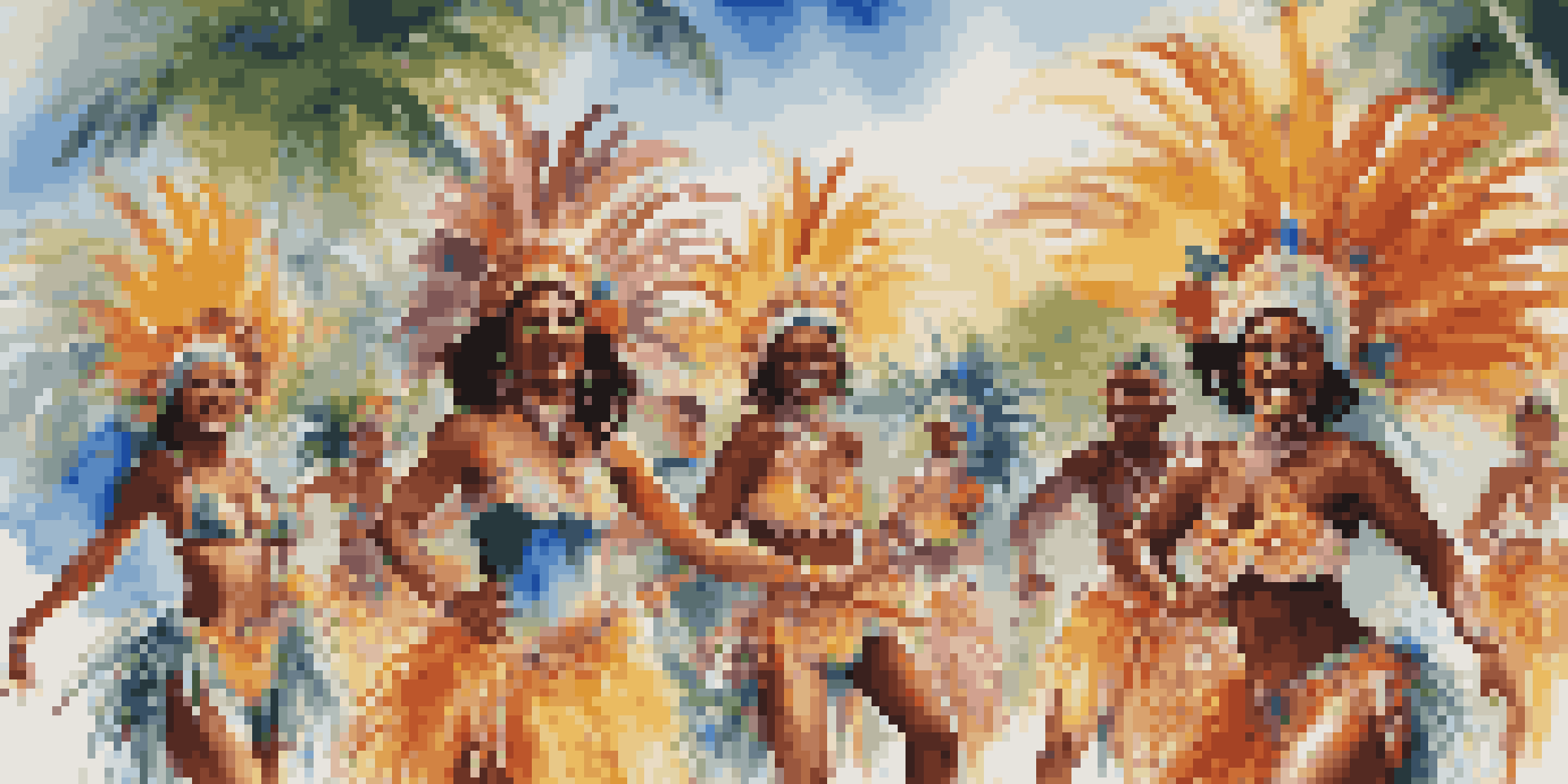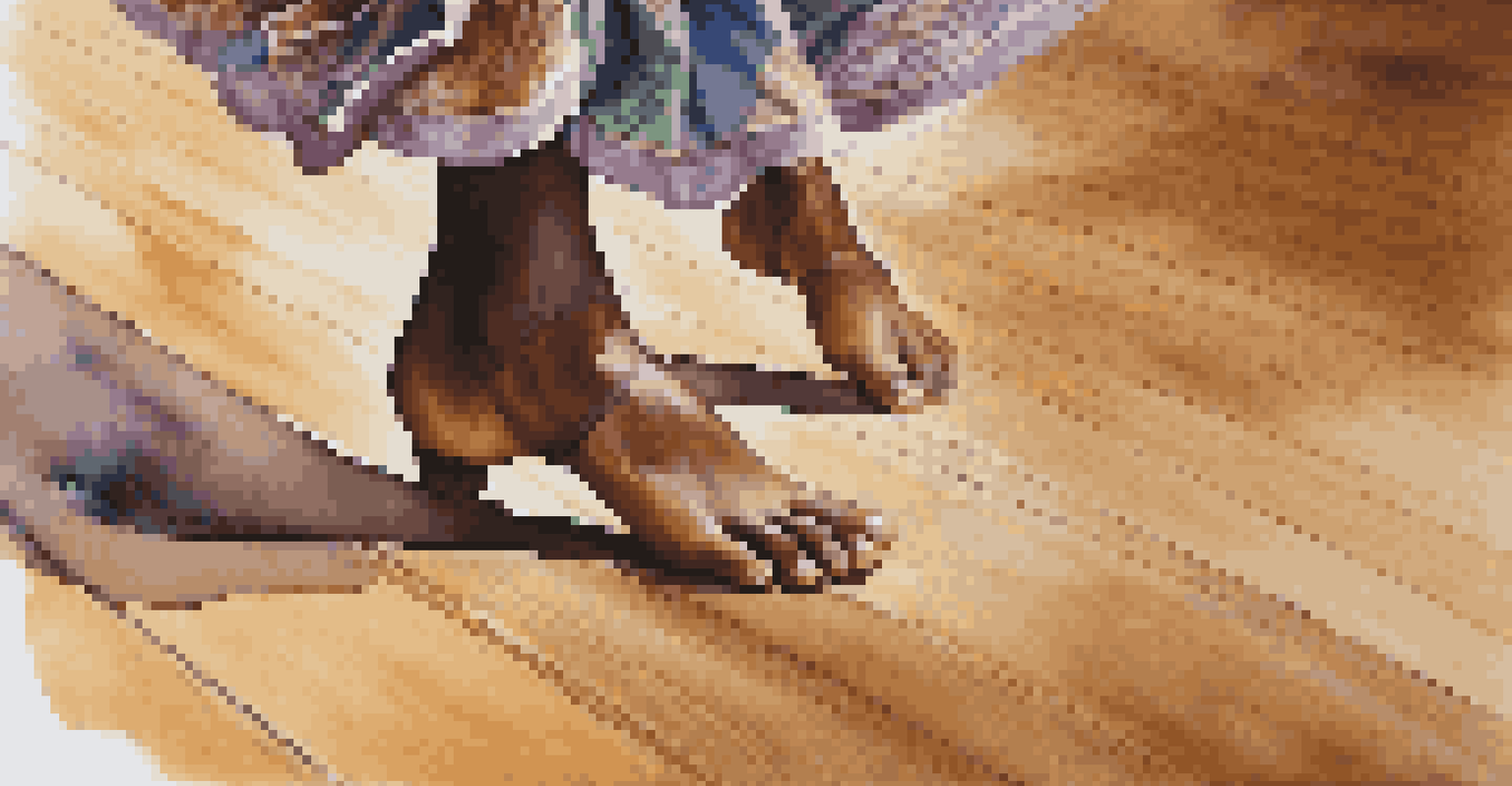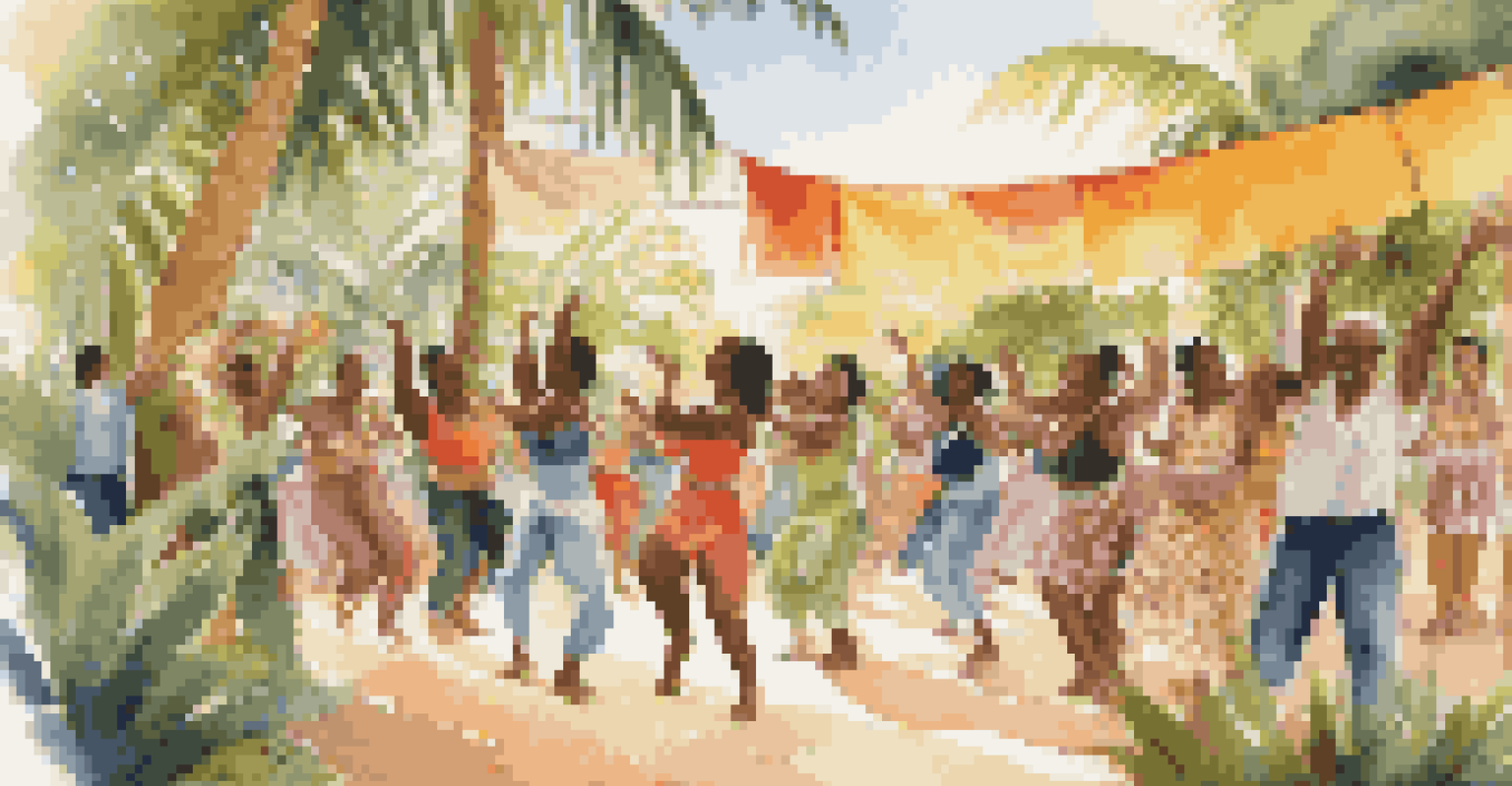The Influence of Caribbean Dance on Global Dance Innovations

Caribbean Dance: A Melting Pot of Cultures and Styles
Caribbean dance is a vibrant tapestry woven from various cultural influences, including African, European, and indigenous elements. This rich blend has given rise to unique dance forms, such as Reggae, Salsa, and Calypso, each with its own rhythmic nuances and steps. As these styles evolved, they absorbed influences from global dance trends, creating a dynamic interplay that has shaped their identities.
Dance is the hidden language of the soul.
For instance, the lively movements in Salsa are deeply rooted in Afro-Caribbean rhythms, showcasing how these dance forms communicate cultural stories and heritage. The passion and energy of Caribbean dance captivate audiences and inspire dancers around the world. It's this infectious spirit that often leads to cross-cultural exchanges and innovations in dance.
Moreover, Caribbean dance serves as a reminder of the region's historical journey, reflecting the struggles and triumphs of its people. This cultural significance resonates beyond the Caribbean, inviting dancers worldwide to explore and incorporate its elements into their own practices.
The Global Appeal of Caribbean Dance Forms
One of the remarkable aspects of Caribbean dance is its universal appeal. From the colorful Carnivals celebrated in Trinidad and Tobago to the energetic dance halls of Jamaica, these forms invite participation and joy. The infectious beats and inviting movements encourage people of all backgrounds to join in, breaking down cultural barriers and fostering a sense of community.

Dance styles like Zouk and Bachata, which have roots in Caribbean culture, have surged in popularity globally, often seen in dance studios and competitions far from their origins. This cross-pollination of styles demonstrates how Caribbean dance has transcended geographical boundaries, influencing dance trends worldwide. By adopting and adapting these styles, dancers create innovative forms that keep the spirit of Caribbean dance alive.
Caribbean Dance: Cultural Fusion
Caribbean dance is a vibrant blend of African, European, and indigenous influences, showcasing unique styles like Salsa and Calypso.
As a result, the global dance scene continuously evolves, with Caribbean influences evident in contemporary choreography and performances. This adaptability speaks volumes about the resilience and creativity of Caribbean dance, proving it can thrive and inspire regardless of location.
How Caribbean Dance Influences Contemporary Choreography
Contemporary dance often draws inspiration from various cultural traditions, and Caribbean dance is no exception. Choreographers are increasingly infusing Caribbean rhythms and movements into their works, creating a fresh fusion that captivates audiences. This blend highlights the versatility of Caribbean dance and showcases its ability to adapt to modern artistic expressions.
The dance is a poem of which each movement is a word.
For example, Broadway shows and music videos frequently incorporate Caribbean-inspired movements, introducing wider audiences to these rich dance traditions. In turn, this not only elevates the visibility of Caribbean dance but also inspires new interpretations and innovations within the genre. The result is a dynamic exchange that enriches both contemporary and traditional dance forms.
Furthermore, dance competitions and festivals often celebrate this fusion, providing a platform for dancers to showcase their unique interpretations. This celebration of diversity demonstrates how Caribbean dance continues to inspire creativity and innovation in choreography around the world.
The Role of Caribbean Festivals in Dance Innovation
Caribbean festivals, such as Carnival and Junkanoo, are not just celebrations; they are incubators for dance innovation. These vibrant events allow dancers to experiment with new styles, often leading to the creation of unique performances that reflect both tradition and modern influences. The communal atmosphere encourages collaboration and creativity, sparking new ideas that can spread beyond the festival grounds.
During these festivals, various dance forms are showcased, often blending traditional steps with contemporary moves. For instance, dancers may incorporate hip-hop elements into traditional Soca, creating a fresh take that resonates with younger audiences. This blending of styles demonstrates how Caribbean dance continues to evolve while maintaining its cultural roots.
Global Popularity of Caribbean Dance
The appeal of Caribbean dance transcends borders, inspiring global dance trends and encouraging participation across diverse cultures.
Moreover, the global attention these festivals receive helps to popularize Caribbean dance on an international scale. As travelers flock to experience the energy and spirit of these events, they often return home inspired to incorporate what they learned into their local dance communities.
The Impact of Social Media on Caribbean Dance Trends
In today's digital age, social media plays a crucial role in promoting Caribbean dance worldwide. Platforms like Instagram and TikTok allow dancers to share their work, reach new audiences, and showcase their cultural heritage. This visibility has opened doors for Caribbean dance forms, making them accessible to a global audience eager to learn and engage.
Viral dance challenges often incorporate Caribbean dance moves, further solidifying their place in global dance culture. For instance, the popularity of dance challenges featuring Reggaeton or dancehall steps has led many to explore the roots and techniques behind these vibrant styles. This blend of entertainment and education helps to keep the essence of Caribbean dance alive while attracting new enthusiasts.
Additionally, social media fosters collaboration between dancers from different backgrounds, encouraging the creation of innovative performances that blend Caribbean styles with other genres. This interconnectedness exemplifies how technology can serve as a bridge, linking cultures and inspiring creativity in the dance community.
Caribbean Dance in Educational Settings
Educational institutions are increasingly recognizing the value of Caribbean dance as part of their curricula. Dance programs are incorporating Caribbean styles, providing students with a diverse range of techniques and cultural insights. This exposure not only enriches their dance education but also fosters appreciation for the cultural significance behind each movement.
Workshops and classes led by Caribbean dance instructors are becoming more common, allowing students to learn from masters of the craft. These experiences often emphasize the importance of storytelling and cultural context in dance, helping students understand the deeper meanings behind the movements. This holistic approach encourages a greater connection to the dance forms and their origins.
Innovative Caribbean Dance Education
Educational programs are increasingly incorporating Caribbean dance, fostering appreciation for its cultural significance and promoting inclusivity.
Moreover, incorporating Caribbean dance into educational settings promotes cultural exchange, allowing students to share their own backgrounds and learn from one another. This exchange fosters inclusivity and respect for diversity, ensuring that the influence of Caribbean dance continues to thrive in future generations.
The Future of Caribbean Dance and Its Global Influence
As Caribbean dance continues to evolve, its impact on global dance innovations will likely grow. The fusion of traditional and contemporary styles, driven by cultural exchanges and technological advancements, promises exciting new directions for Caribbean dance. Dancers and choreographers are constantly finding inspiration in the past while looking toward the future, ensuring that these styles remain relevant and dynamic.
Moreover, the global dance community’s increasing appreciation for diversity and cultural heritage paves the way for Caribbean dance to take center stage. With more opportunities for collaboration and exploration, we can expect to see even more innovative works that pay homage to Caribbean roots while pushing creative boundaries.

Ultimately, the future of Caribbean dance lies in its ability to adapt and inspire, maintaining a dialogue between the past and present. As new generations of dancers embrace and reimagine these traditions, Caribbean dance will undoubtedly continue to leave a lasting mark on the global dance landscape.